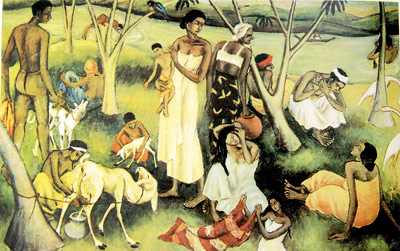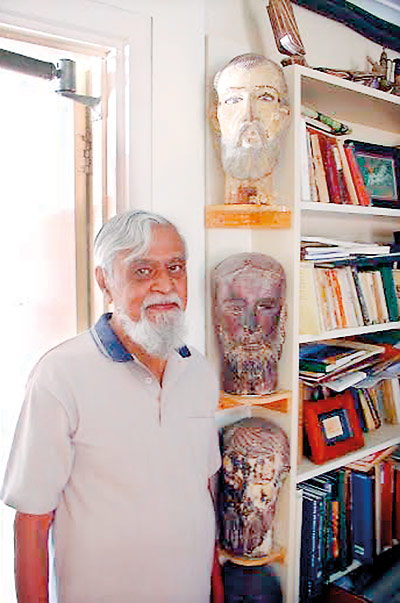News
Gabriel, the last of the ’43 group is no more

Village Scene: A Richard Gabriel painting
One of Sri Lanka’s contemporary greats, the artist Richard Gabriel, the last surviving memberof the country’s internationally famed ’43 Group died in Australia on Friday morning, (February 19) on his 92nd birthday.
A founder member of the original ’43 Group, Richard Gabriel was the youngest of the august company spearheaded by Lionel Wendt – of George Keyt, Geoffrey Beling, George Claessen, Justin Daraniyagala, Aubrey Collette, Ivan Peries, Harry Pieris and L.T.P. Manjusri who made a significant impact locally and internationally, melding traditional art forms with the modernity of the West to present a distinctively Lankan experience.
Gabriel’s work was exhibited in the UK and France in 1952-53 and at the Venice and Sao Paulo Biennales in the following years and is in the permanent collection of the Musee de Petit Palais in Paris.
His long-time friend and biographer Neville Weereratne ( ‘The Art of Richard Gabriel’) wrote, “In his work as an artist, Gabriel painted images of his beloved people, the fisherman, the farmer, the mother and her child, all of them in their rich, familiar and beautiful landscape.
There is persistently a pastoral quality, an air of tranquillity punctuated, alas, by the unavoidable observation of the conflict between man and beast.”
A simple, unassuming, deeply religious man all his life, Gabriel was born in Matara on February 19, 1924. The family moved to Colombo after his father’s early death and the young Richard studied at St. Peter’s College, Bambalapitiya.
His considerable artistic potential was spotted when he took part in a Government Information Department exhibition of paintings in 1943 – ‘The Ceylon War Effort Pictures’ and won the princely sum of Rs. 200 for the four paintings he had submitted.

Richard Gabriel at his home in Melbourne standing next to his 'Saint heads'
In an interview with the Sunday Times in 2008, he recalled how when he came down in Maths, and hence failed his Senior School Certificate exam, his mother had told him, “God has given you a gift, why don’t you use it”, without insisting that he take the safe path of a government job.
He was hired as an art teacher in 1944 by the visionary Rector Fr. Peter Pillai at St. Joseph’s College, Colombo when he was just 19 and later also taught many aspiring artists at the Cora Abraham Art School.
He had formal training abroad when a British Council scholarship took him in 1952 to the Chelsea School of Art. Over the course of his long career, he experimented with linocuts and wood cuts, etchings, sculptures and wall murals. He was made an honorary member of the Michelangelo Academy of Florence in recognition of his work with woodcuts and etchings.
A prolific artist, his paintings would lie stacked in his humble home in Pannipitiya. But his work in many Catholic churches, at St. Theresa’s, Thimbirigasyaya, the Jesuit Chapel in Bambalapitiya, the National Seminary at Ampitiya, Kandy and St. Aloysius’ Seminary in Borella among others saw ordinary Sri Lankans appreciate his genius.
“I always found Richard Gabriel’s work refreshingly different,” artist Michael Anthonisz said. “He did not try to ape anyone else’s style – his lines were pure and from the heart as he depicted the simple country folk in almost all of his work. His affinity to the rural folk and the simplicity of his own thinking and lifestyle came through in his work.
“A deeply religious soul – his work at St Theresa’s and at the church in Pannipitiya and the beautiful sculpture at the Jesuit Chapel on Clifford Place, Bambalapitiya will live on as a testimony of his faith.”
Married to the artist and art teacher Sita Kulasekera in 1951, after her death he migrated to Australia in 2002 to be with his children, son Angelo and daughter Rene, and continued his lifelong love of painting the people and scenes of his beloved homeland.

